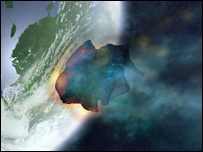However, this is still a greater distance than the moon

This coming Monday, in the evening hours, it will be possible to see an asteroid at its closest point to the Earth, however, its distance from the Earth will still be greater than the distance of the Moon from the Earth.
Scientists closely monitor asteroids that pass by the Earth. Such a large asteroid should pass by us in the next few days, but will not cause any danger. The asteroid, whose diameter is estimated to be approximately 800 meters, will pass approximately 433 thousand km from the Earth, only slightly further than the distance of the moon from us. On Monday evening it will be possible to observe it through amateur telescopes.
Asteroid 2004 XP14 poses no threat to Earth, says Don Yeomans, head of NASA's Near-Earth Object Project.
"To observe it, one must look towards the constellations Perseus, Cassiopeia and Caphaus. It will appear as a moving dot against the background of the stars," says Roger Sinnott of Sky and Telescope magazine.
The asteroid is expected to pass by the Earth on more occasions, but scientists believe that it will be many years before then. The asteroid discovered in 2004 is the largest of several dozen asteroids that have passed by the Earth in recent years. "Such a close approach is considered rare for objects of this size," Yeomans says.
American scientists will use radar beams at the Goldson Observatory in the Mojave Desert to learn more about the shape of the asteroid, and will also try to analyze its future trajectory.
This asteroid is one of 783 asteroids classified as potentially hazardous by the Minor Planet Center in Cambridge, Massachusetts, due to its size and proximity to Earth.
Drafting and editing: H. J. Glykasm, translations and technical writing
